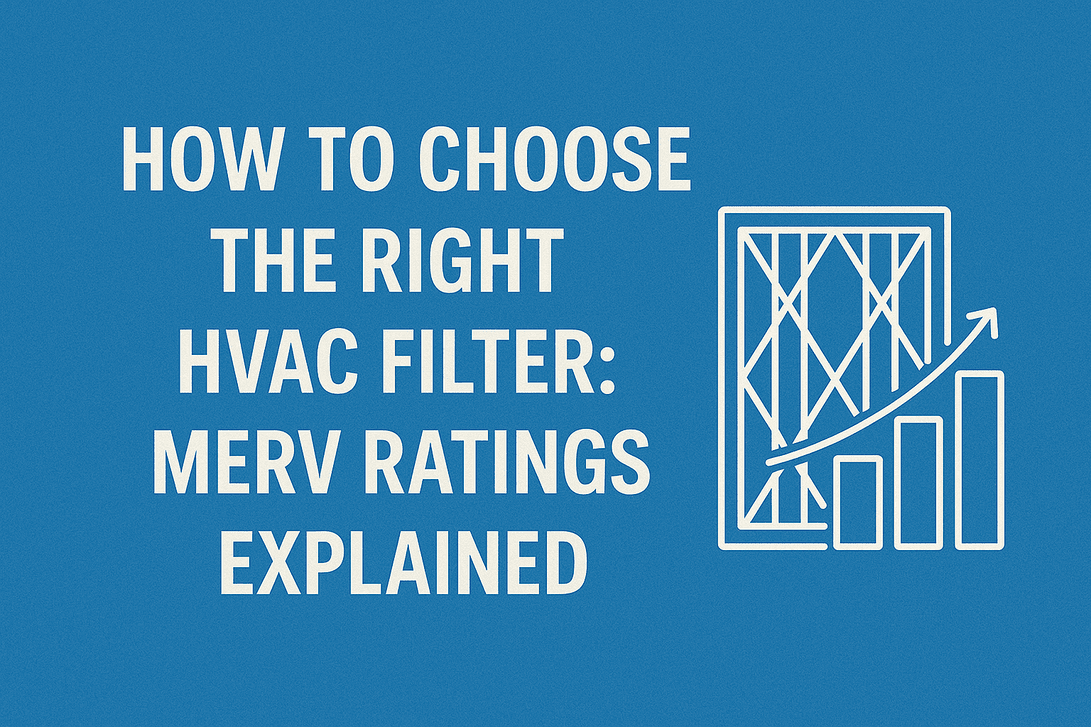When it comes to maintaining a healthy indoor environment and protecting your HVAC system, few choices matter more than selecting the right air filter. Among the different ratings available, the MERV rating (Minimum Efficiency Reporting Value) is the industry-standard benchmark that determines how effectively a filter captures airborne particles. Choosing wisely not only improves indoor air quality but also enhances the efficiency and lifespan of your HVAC system.
In this comprehensive guide, we break down what MERV ratings mean, how to choose the right HVAC filter, and what factors to consider for your home or business.
What Is a MERV Rating?
The MERV rating is a scale developed by the American Society of Heating, Refrigerating, and Air-Conditioning Engineers (ASHRAE) to measure the effectiveness of air filters. The scale ranges from MERV 1 to MERV 20, with higher numbers representing filters that trap smaller particles more efficiently.
- MERV 1–4: Basic filtration for large particles such as dust and pollen.
- MERV 5–8: Standard residential filters, good for mold spores, pet dander, and dust mites.
- MERV 9–12: Enhanced residential or commercial use, effective against fine dust, smoke, and some bacteria.
- MERV 13–16: Superior filtration, capable of capturing viruses, bacteria, and allergens. Often used in hospitals and labs.
- MERV 17–20: High-efficiency filters such as HEPA, used in cleanrooms and sensitive environments.
Why MERV Ratings Matter for Your HVAC System
The right filter ensures both clean air and system performance. However, choosing a filter that is too restrictive for your system can lead to reduced airflow, higher energy costs, and unnecessary wear on equipment. That’s why it’s critical to balance air quality needs with HVAC system compatibility.
How to Choose the Right MERV Rating
When deciding on a filter, consider the following:
1. Household Needs
- Pets at Home: Pet owners may benefit from MERV 8–12 filters to trap dander and hair.
- Allergy Sufferers: A MERV 11–13 filter helps capture pollen, mold spores, and fine allergens.
- Smokers Indoors: Choose MERV 13+ for smoke particles and lingering odors.
2. Health Requirements
If anyone in your home has asthma, respiratory issues, or a compromised immune system, opt for MERV 13–16 for better filtration of harmful airborne particles.
3. Energy Efficiency
Higher MERV filters can restrict airflow, making your HVAC system work harder. Always verify that your system is designed to handle higher-rated filters before upgrading.
4. System Compatibility
Check your HVAC manufacturer’s specifications. Using a filter with a MERV rating beyond what the system supports can cause strain and potentially damage the unit.
Comparison: MERV vs. HEPA vs. Other Ratings
While MERV is the most common scale, it’s helpful to understand how it compares to other systems:
- HEPA (High-Efficiency Particulate Air) filters surpass MERV 17, capturing up to 99.97% of particles as small as 0.3 microns.
- MPR (Microparticle Performance Rating) by 3M and FPR (Filter Performance Rating) by Home Depot are alternative consumer-oriented ratings, but MERV remains the industry standard.
Understanding Filter Materials
The efficiency of a filter isn’t just about the MERV number. The material composition affects durability and performance:
- Fiberglass filters: Low cost, low MERV (1–4), minimal protection.
- Pleated filters: Polyester or cotton, typically MERV 5–13, better for households.
- Electrostatic filters: Attract particles using static charge, effective for allergens.
- HEPA filters: Premium option, used in hospitals, labs, and homes with severe allergy concerns.
Pros and Cons of Different MERV Ratings
| MERV Rating | Pros | Cons |
| 1–4 | Affordable, low airflow resistance | Poor filtration, little protection |
| 5–8 | Good balance for most homes, captures common allergens | Limited protection against fine particles |
| 9–12 | Superior residential use, traps smoke and smaller allergens | May strain older HVAC systems |
| 13–16 | Hospital-grade filtration, excellent for allergies | Higher cost, requires compatible system |
| 17–20 | Cleanroom-level air purity | Expensive, not compatible with standard HVAC |
Signs You Need to Upgrade Your Filter
- Frequent allergy flare-ups indoors
- Visible dust accumulation despite regular cleaning
- Increased HVAC energy bills
- Poor air circulation or hot/cold spots in your home
If you notice any of these, consider upgrading to a higher MERV filter that matches your system’s capacity.
How Often Should You Replace HVAC Filters?
Filter replacement depends on MERV rating, material, and usage:
- MERV 1–4: Every 30 days
- MERV 5–8: Every 60–90 days
- MERV 9–12: Every 90–120 days
- MERV 13+: Every 6–12 months (depending on conditions)
Homes with pets, large families, or high usage may require more frequent changes.
Practical Tips for Maximizing HVAC Filter Efficiency
- Check Your Filter Monthly – especially during high pollen or allergy seasons.
- Seal Air Leaks – prevent contaminants from bypassing your filter.
- Schedule HVAC Maintenance – professional cleaning and tune-ups improve system longevity.
- Upgrade Gradually – don’t jump from MERV 4 to MERV 16 without consulting a technician.
Final Thoughts on Choosing the Right Filter
Selecting the right MERV rating for your HVAC filter is about striking the perfect balance between indoor air quality and system efficiency. While higher MERV filters capture more pollutants, they can strain systems not designed for them. By assessing your health needs, household environment, and HVAC capacity, you can make the most informed decision for long-term comfort and performance.


